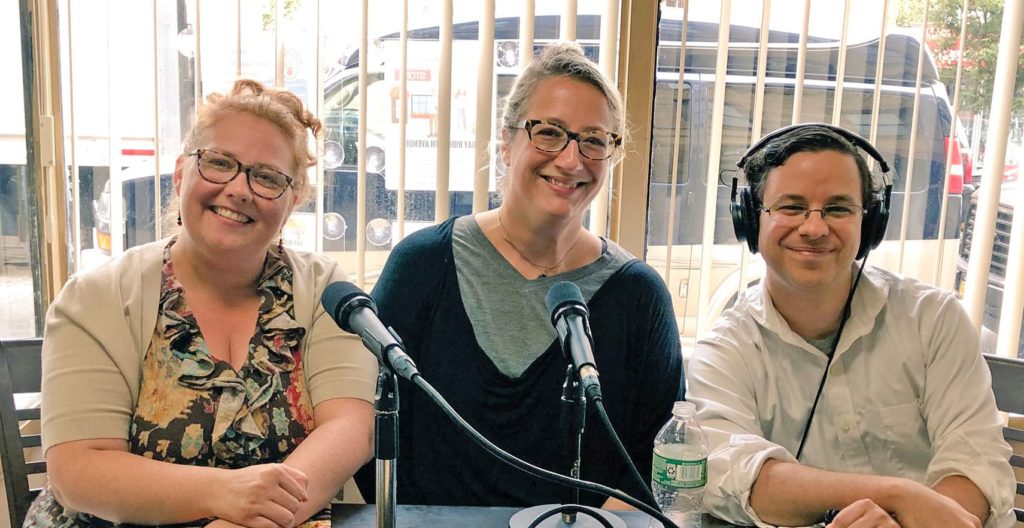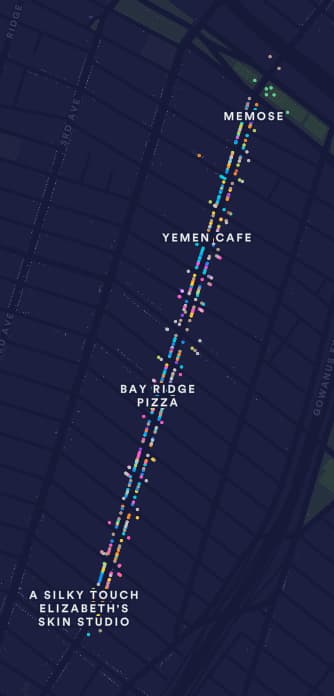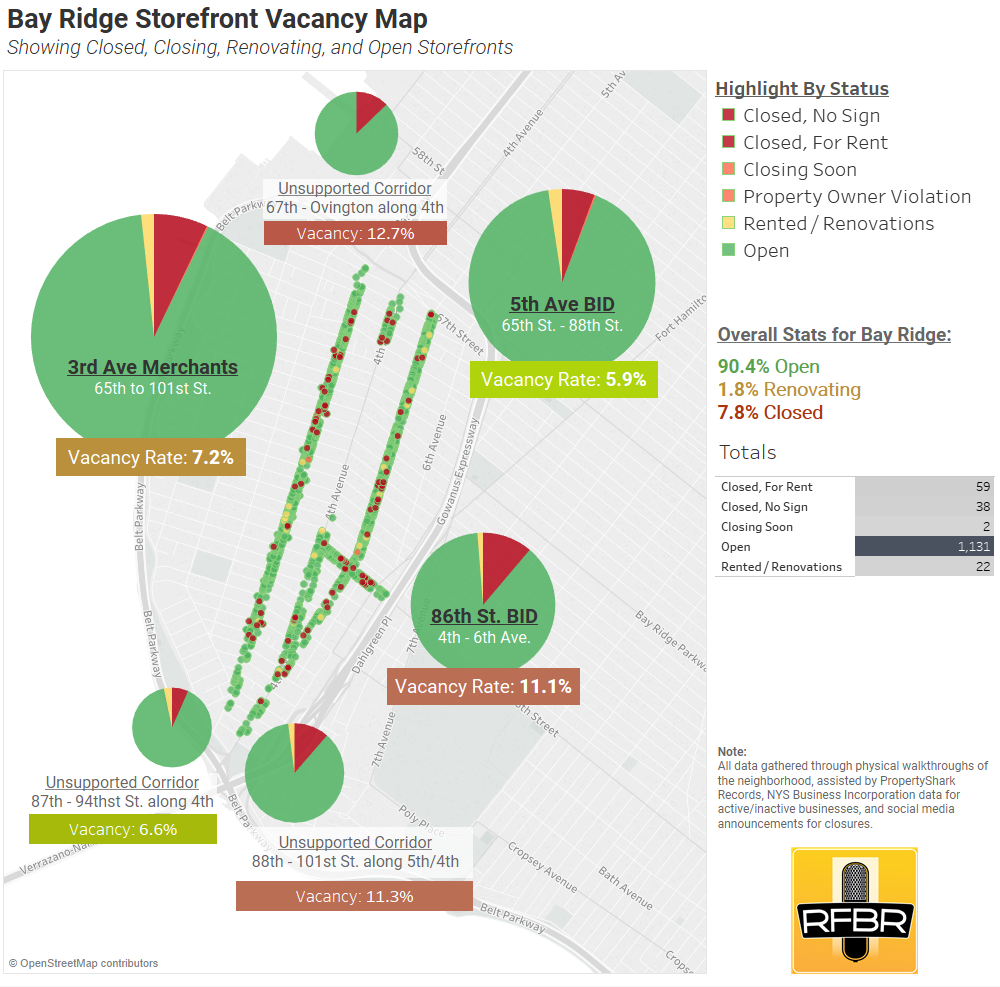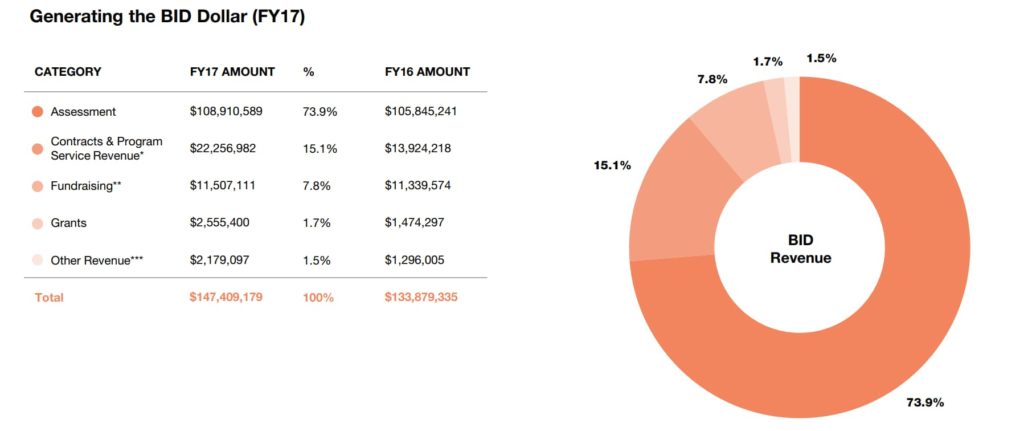Bay Ridge is teeming with commercial possibilities, and is home to three major shopping avenues in close proximity. Today we’ll learn what it takes to help them flourish. We sat down with Amanda Zenteno, the Executive Director of the Bay Ridge 5th Avenue BID, or Business Improvement District.
We’ll cover what a BID does and how it’s organized, and what services it provides to the businesses it serves. We also talk about keeping commercial corridors clean and dispelling misconceptions about vacant storefronts. Support your local businesses and have a listen!

Upcoming News and Events
Electing a new Public Advocate
In our previous episode, we said we’d keep you up to date on the Public Advocate’s race. We don’t have enough time to interview and edit each candidate, but other Bay Ridge folks are picking up the slack! Our local progressive community center, Solidarity Space, in partnership with Bkylner, will be interviewing candidates and giving the public a chance to ask questions. Here’s the schedule so far…
| Assemblyman Ron Kim | Monday, January 7th |
| Councilman Jumaane Williams | Tuesday, Jaunary 8th |
| Assemblyman Danny O’Donnel | Thursday, January 10th |
| Councilman Rafael Espinal | Thursday, January 17th |
| Assemblyman Michael Blake | Friday, January 18th |
| Melissa Mark-Viverito | Thursday, January 24th |
All events will be held at Solidarity Space at 307 82nd Street, right off 3rd Avenue. Doors at 6pm!
Be sure to check out Solidarity Space’s events calendar for more as they get added!
Bike Lane Visioning Session
In case you hadn’t noticed, we’ve been following the progress of our Community Board in improving alternative transportation in the neighborhood. Our co-host Dan even wrote an article in Streetsblog about it! It’s all finally coming to fruition with a big visioning session held by the Department of Transportation and Community Board 10.
A visioning session basically involves a bunch of members of the public, who have experience and knowledge about an issue, getting together to plan what they want to see in their neighborhood; in this case, bike lanes! By getting cyclists in the room to make their own ideal plan, our civic agencies can better understand the needs of a formerly disenfranchised community.
Push-back from Community Board Members
Sadly, we’ve seen the Community Board president Doris Cruz be very dismissive of the visioning process, telling opponents of bike lanes to attend the visioning session because cyclists are too well “networked”.
Firstly, we’re saddened that Doris dismisses cyclists as being “out in force” and in need of being countered. They wouldn’t need to be “well networked” in the first place if the Community Board was conducting proper outreach to this subsection of the neighborhood. Also… they are networked locally through groups like Bike South Brooklyn, which relies on the volunteer work of a mere handful of people, and it’s important not to dismiss that sort of activist work.
(By the way, nearly 70% of Bay Ridge residents have a “car free commute”, so we disagree with the fact that more drivers participating in designing our public streets is “balanced”.)
Secondly, it sounds like Doris doesn’t understand the goals of a visioning session, which to be fair the DOT did not make clear in December. The January 16th meeting is being held determine the needs of local cyclists and give them a space to freely express themselves. It is in later meetings and sessions that visioning session data would actually get hammered out into a feasible plan, and in which more voices need to be heard.
So, if you are a cyclist, the DOT and Community Board need to hear from you on January 16th! Be sure to RSVP on Facebook and head over to Shore Hill Housing at 9000 Shore Road right off 91st Street. Meeting starts at 7pm!
Show Notes
Keep in touch with the Bay Ridge 5th Avenue BID
Remember to follow the BID on Facebook, Twitter and Instagram!
And if you have a moment, remember to check out the BID’s website to learn more about their mission. If you’re feeling particularly geeky, you can check out their budget breakdown in their financials section.
You can also check out their ongoing “Meet the Merchant” series on Vimeo, which highlights various businesses such as Skinflints, Provident Loan Society, and Schnitzel Haus.
Most importantly, you can check out the services and resources they can leverage to assist merchants on 5th avenue. This includes information from how to get comply with the new minimum wage law put into place for 2019, to info from the Department of Consumer Affairs, the Department of Small Business Services, and the Department of Health.
Marketing 5th Avenue
You can definitely see the effort the BID has put into helping promote and provide a web presence for it’s stores and businesses.
For example, the BID has put up this pretty cool interactive map of 5th Avenue online, where you can search all of the stores by category and type. If you aren’t sure if the avenue has something you want, it’s worth double-checking!
We’ll be adding more information on how 5th Avenue is marketing itself to the shownotes soon, by the way!

The truth about closed storefronts
Sadly, there is a lot of fear concerning empty storefronts in Bay Ridge. Recent articles using (perhaps dubious) contractors have estimated nearly 20% of Manhattan storefronts are empty. This doesn’t apply to Bay Ridge.
At least, not in areas where neighbors, activists, and store owners are organized and well-coordinated.

Comparing Avenues
You can see in the interactive graphic above that, overall, Bay Ridge has a 7.8% storefront vacancy rate. Even so, it isn’t helpful to make sweeping generalizations based on that number. As Amanda repeated throughout the episode, each commercial area has their own needs and challenges.
You can see different areas have different vacancy rates. For example, the Bay Ridge 5th Avenue BID in January 2019 had about a 5.9% vacancy rate. As Amanda said, you don’t want it too low or nobody can open new stores. According to the NY Times and brokers, 5 percent is an ideal rate. For comparison, 5th Avenue south of 88th street has a nearly 11.3% vacancy rate, almost double that of the BID area. Businesses here have no organizing structure or supplemental services. They are also further apart and have more parking lots. In short, it’s less attractive to foot traffic and is generally worse off.
3rd Avenue Merchants, having a large residential area nearby to the west, are faring better at 7.2% vacancy. Additionally, 3rd Ave vacancies are clustered around specific property owners. That’s also the case for the 86th Street BID, where almost all of their 11.1% vacancies are clustered next to each other indicating a property owner hoping for a large-scale renter to move in.
Finally, it’s important to point out larger context for these numbers: nowhere in Bay Ridge do retail vacancies exceed the national average. On the whole we are performing above-average.

Is it Gentrification?
The answer is simple: no.
Firstly, Bay Ridge has never lacked a gentry. Bay Ridge has been “gentrified” ever since we replaced our farmland with Shore Road mansions and brownstones. We have historically been an upper-middle-class neighborhood. Indeed, in some maps Bay Ridge is totally left out of the gentrification debate, simply hand-waved away as “higher-income”.
Secondly, average income levels are not being rapidly overtaken by rent increases, one of the basic metrics of gentrification. In 2018, according to the NYU Furman Center’s State of NYC’s Housing and Neighborhoods Report, the median household income from 2010 to 2016 rose from $53,920 to $67,870, a 20% increase. Median rents increased only slightly more, by 25%. Even more interesting, from 2016 to 2017, average rents actually dropped from $2,000 to $1,900. This isn’t the kind of trend you’d expect to see in a gentrifying neighborhood. Indeed, the poverty rate for people aged 65 and older has dropped, from 15% in 2010 to 10% in 2016.
If you can gather anything from the detailed neighborhood metrics, you’ll learn one thing: Bay Ridge isn’t changing very dramatically at all.
As we discussed in the episode, businesses opening and closing always occurs. Nothing can stay the same forever. Younger generations are opening stores. We should not confuse an upcoming generation of entrepreneurs as foreign, bad, or out of character with the neighborhood.
Keeping the Avenue clean
Yes, the Sanitation Department cleans out trash cans on avenues, but that’s all they can do. If someone doesn’t put their trash in a can, it’s up to street sweepers to (eventually) clean up the mess. Because of this, many BIDs form expressly to deal with sanitation issues on busy commercial streets.
The Bay Ridge 5th Avenue BID has four full-time staff that go up and down 5th Avenue, from 88th to 65th Street. They pick up litter and generally keep the sidewalks looking good. On snowy days, they also help shovel curb-cuts and help make sure the avenue is safe. As Amanda mentioned, this service alone is perhaps worth the BID assessment fees.
Hours Spent Cleaning: 8,900
-BAY RIDGE 5TH AVENUE BID CLEANING STATS FOR FY 2017
Trash Bags Collected: 36,000
Graffiti Removed: 3,600
Other groups usually need to resort to other methods to keep trash cans clean. For example, 3rd Avenue merchants, who pay $175 annually in dues, have relied in the past on the Sanitation Department’s “Adopt-A-Basket” program. This is a volunteer program where store owners donate money and keep the cans clean themselves. The program is similar to Fight Back Bay Ridge’s recent efforts at the Dyker Heights holiday lights.
Indeed, perusing social media about Bay Ridge, most sanitation complaints seem to come from 3rd Avenue.
Funding a BID
In the episode, we discussed the nuances of an assessment versus a “tax”. This indeed is a highly contentious issue. Disliking the assessment and how it’s managed is often the primary reason people oppose BIDs, especially amongst merchants and store owners.
With 359 storefronts and an annual assessment income of $427,000 [see financial statements], the cost to store owners in the BID is about $1,190 per year.
However, Amanda mentions that the Bay Ridge 5th Avenue BID primarily bases its assessment on store frontage. This means that the smaller a storefront is, the less their BID fee is. Most stores would pay slightly less than the $1,190 average rate, and bigger stores like banks would pay slightly more.
We asked Amanda about alternative funding streams for the Bay Ridge 5th Avenue BID. She mentioned a desire to increase event sponsorships and service funding, as well as the difficulty in applying for grants. This isn’t unusual: most recent BID trend report shows that nearly 73% of all BID funding comes from assessments alone. The second largest income stream is from Contracts & Program Service Revenue (such as sponsorships at events, concession sales, parking lot rentals, ad revenue). Only 1.7% comes from grants, usually for the 35 BIDs that exist in low-to-moderate income neighborhoods.

Staffing a BID
We mentioned that the Bay Ridge 5th Avenue BID has only recently upgraded to 2 full-time staff members. You can actually see the extreme variety of BID sizes in the diagram below. Our little Bay Ridge 5th Avenue BID sits in the center among the majority of BIDs with small 1-2 person staffing structures. The 86th Street BID doesn’t even appear, having no full-time staff members, much like the 5th Avenue BID for much of it’s history
Amanda mentions James “Jim” Clark as essential to the BID’s formation. Jim, a Dyker Heights resident who runs 14 Apollo Real Estate, was a longtime president of the BID’s Board of Directors, and now serves as treasurer. You can read more about Jim in local newspapers; he’s had a long run and extensive involvement in local civic organizations.